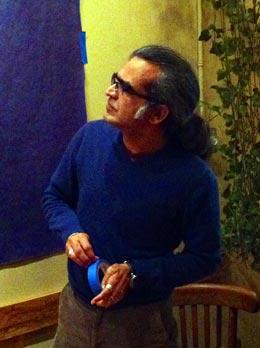Artist Revisions Komagata Maru

Raghavendra Rao is an award winning visual artist based in Bangalore and Vancouver. Over the past twenty years, his works have been exhibited around the world in India, Sweden, Scotland, and Canada. A talented musician, singer, and scholar, Raghavendra Rao is a featured artist in “Ruptures in Arrival: Art in the Wake of the Komagata Maru,” now on at the Surrey Art Gallery.
When did you first learn about the Komagata Maru?
I first learned about the Komagata Maru In 2012, from Dr. Anne Murphy while she was working on events related to the centenary commemoration of the founding of the Gadar party. Later I watched ‘Continuous Journey’ by Ali Kazimi as part of that program and listened to scholars and others talk about it.
What inspired you about the story?
I wanted to do some work on the Komagata Maru incident after I attended the events on the Gadar party, and spoke with a number of people including Anne. I had plans to make three-dimensional interactive pieces, but, as I looked at the archival pictures of the people on board the ship, I felt like making portraits of them. I looked for photographs of people around that time in the archives online and found many photographs of South Asian men doing different kinds of manual labour. I decided at that point to make portraits of these in a style that would resemble aristocrats and kings – centrally placed, and almost regal. But, in this case, with my work, you would see a patch of red around them, which could connote violence and betrayal.
To me, the most poignant experience was while I was working on the paintings, looking at the archival pictures for so long… it made me feel as though I know these people. It is like some kind of connection that got created during the process.
Tell us about the “Visions of the Living Past: Visions of the Komagata Maru” exhibit in Bangalore.
It was received really well. Each and every person asked ‘How come we do not know of this really important part of our history?’ It was interesting for me as I am not a Punjabi and most of the viewers were not Punjabis but they all said ‘our history.’ It is significant to notice that it is not just a ‘Punjabi – Canadian’ story but a vital part of Indian history too, South Asian history too.
How do the themes of your work at the Surrey Art Gallery connect to larger themes in your practice?
I have interacted with artists from different parts of the world and I understand how processes of making art are influenced by political and social contexts. These interactions have helped me in situating my own, as I call it, “context specific” work. When I began the transition of moving to Vancouver, I started understanding this new ‘context’ slowly. ‘The Imaginary Landscape of the Komagata Maru: Visions of the Living Past” has emerged from my Canadian experience in the last year and a half. Through this, I reflect on and imagine the experience of early South Asian settlers to Canada at the beginning of the twentieth century. And it helps me to understand my own experience in a fuller way.
Why is the Komagata Maru narrative important today?
It is as important for white Canadians as it is for South Asian Canadians, Chinese Canadians, or Members of the First Nations. There are ramifications of it today and we also find parallels in immigration policy. This story speaks to all of us, and tells us about the present as well as the past. We need to listen to it to understand ourselves and our world, and particularly if we want to change that world for the better.
Leave a comment









